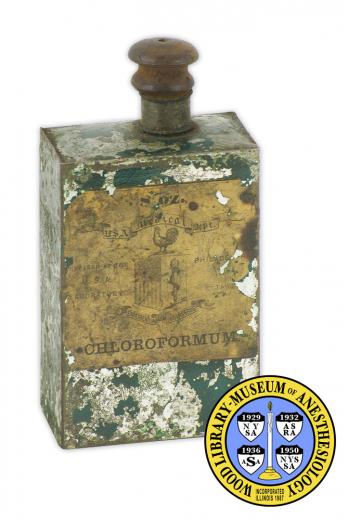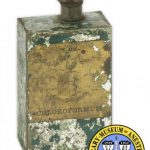Chloroform Tin
The U.S. Army Surgeon’s Field Companion, also called the Coolidge Carrier Set, was a kit issued to Union surgeons during the American Civil War (1861-1865). It was designed by Medical Inspector R. H. Coolidge in 1863 to take the place of a heavier and more cumbersome knapsack. The kit was a compact, rectangular case that included a tin of chloroform among the other supplies, such as ipecac, ginger, opium, quinine, whisky, bandages, needles and sutures.
During the 1860s, chloroform was often administered by pouring it onto a cloth or sponge which was then held over the patient’s nose and mouth. Chloroform was reapplied in drops to refresh the cloth. Chloroform and ether were used by both the Union and Confederate forces during the American Civil War. Most drugs were manufactured in the North, so after US forces took control of the railways, Southern hospitals had difficulty in obtaining supplies.
Catalog Record: Chloroform Tin
Access Key: aiju
Accession No.: 2006-05-09-2 D
Title: Chloroformum : [Coolidge field companion chloroform tin].
Author: Coolidge, Richard H. (Richard Henry), 1816-1866.
Title variation: Alt Title
Title: U.S. Army chloroform tin.
Title variation: Alt Title
Title: Civil War chloroform tin.
Title variation: Alt Title
Title: Coolidge Field Case chloroform tin.
Title variation: Alt Title
Title: Coolidge Surgeon’s Companion chloroform tin.
Title variation: Alt Title
Title: Chloroformum.
Publisher: 1865.
Physical Description: 1 tin : tin plated steel ; 10 x 6 x 4 cm.
Subject: American Civil War.
Subject: Military Medicine.
Subject: Chloroform.
Subject: Tin.
Subject: Drug Packaging.
Note Type: General
Notes: Title from manufacturer markings on the tin. Subtitle is descriptive and
based on the Wood Library Museum’s name for the object.
Note Type: With
Notes: Issued with the Coolidge Field Case.
Note Type: Citation
Notes: Barnes JK; United States Surgeon-General’s Office. The Medical and Surgical
History of the Civil War. Part 3, vol. 2. Washington: Government Printing
Office, 1883:915-916.
Note Type: Physical Description
Notes: Green painted and/or varnished, small, rectangular, metal container with a
capped, narrow neck; paint or varnish considerably chipped; The height of 10
cm. includes neck and wooden stopper; Stains on and wearing of paper label on
front of tin; Text and images on label include “8 oz.” [top banner] — “U.S.A
Medical Dept” — [center is a Rooster above a shield with U.S. flag on left
and caduceus on right. To the left of the shield is] “Prepared at the U.S.A.
Laboratory” [To the right of the shield is] “Philadelphia 1865” — [Below
shield on left] “experimentia” [Below shield on right] “progressus” —
[center bottom of label] “Chloroformum”.
Note Type: Reproduction
Notes: Photographed by Mr. William Lyle July 13, 2010.
Note Type: Historical
Notes: This type of chloroform tin was a part of the Coolidge Carrier Set, also
referred to as the U.S. Army Surgeon’s Field Companion, Coolidge Field Case,
or Surgeon’s Companion, which contained, among other items, quinine, opium,
sutures and bandages. It was arranged by Medical Inspector R. H. Coolidge in
the early part of 1863 to take the place of a heavier and more cumbersome
knapsack (Barnes, 1991).
Note Type: Historical
Notes: Chloroform and ether were used by both the Union and Confederate forces
during the American Civil War. Most drugs were manufactured in the North, so
after US forces took control of the railways, Southern hospitals had
difficulty in obtaining supplies.


